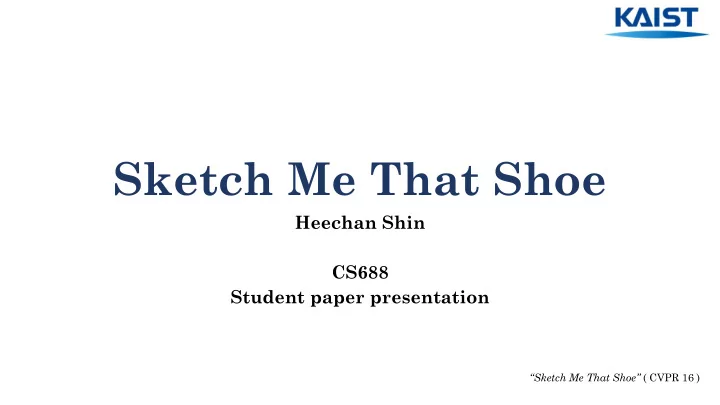

Sketch Me That Shoe Heechan Shin CS688 Student paper presentation “Sketch Me That Shoe” ( CVPR 16 )
Contents • Problems • Solution • Dataset • Methodology • Experiment
Announcement • Most of contents of this presentation comes from materials of author’s CVPR presentation.
Problems • Sketch Based Image Retrieval (SBIR)
Problems • SBIR • Pros • No need for complicated description • No need for photos • Cons • Sketch is highly abstract • Heterogeneous domains ( sketch ↔ image )
Problems • Previous works • Eitz, Mathias, et al. “An evaluation of descriptors for large -scale image retrieval from sketched feature lines.” Computers & Graphics, 2010 • Eitz, Mathias, et al. “Sketch -based image retrieval: Benchmark and bag-of-features descriptors.” TVCG, 2011 • Hu, Rui , et al. “Gradient field descriptor for sketch based retrieval and localization.” ICIP, 2010 Category-level SBIR
Problems Category-level SBIR Instance-level SBIR This work wants to find fine-grained instance-level SBIR
Problems • Sketch Based Image Retrieval (SBIR) • Sketch • Edge maps ( automatically generated ) • Professional drawings ( skilled artist ) • Free-hand sketches ( amateur )
Problems • Reasons of challenging • Sketch is highly abstract Cons of SBIR • Heterogeneous domains ( sketch ↔ image ) • Want to capture the fine-grained similarities with free-hand sketches • No large-scale dataset exists
Solutions • Contributions • Constructing fine-grained SBIR dataset • Pre-training with sketch-specific data augmentation
Solutions • Constructing fine-grained SBIR dataset 1. Data collection 1) Collecting photo images 419 shoe images from UT-Zap50K, 297 chairs from IKEA, Amazon and Taobao • 2) Collecting sketches Recruiting 22 volunteers •
Solutions • Constructing fine-grained SBIR dataset 2. Data annotation 1) Attribute annotation 2) Generating candidate photos for each sketch 3) Triplet annotation
Solutions • Learn a feature space using triplet loss • Always, 𝐸 𝑔 𝜄 𝑞 + 𝜄 𝑞 − 𝜄 𝑡 , 𝑔 < 𝐸 𝑔 𝜄 𝑡 , 𝑔 • Loss function : 𝑀 𝜄 𝑡, 𝑞 + , 𝑞 − = max 0, Δ + 𝐸 𝑔 𝜄 𝑞 + 𝜄 𝑞 − 𝜄 𝑡 , 𝑔 − 𝐸 𝑔 𝜄 𝑡 , 𝑔 Where, 𝐸 ∙ is euclidean distance, 𝑔 𝜄 ∙ is feature embedding function
Solutions • Using three identical Sketch-a-Net* CNNs with Siamese network approach * Q. Yu, et. al., “Sketch -a- net that beats humans” BMVC, 2015
Solutions • Re-train each Sketch-a-Net with Data augmentation
Solutions • Data augmentation • Stroke removal • Broad outline is important • Longer line is important • Sketch is drawn from outside • Stroke deformation • Using Moving Least Square algorithm
Solutions • Data augmentation
Experiment • Settings • Data • 419 shoes ( 304 for training + 115 for testing ) • 297 chairs ( 200 for training + 97 for testing ) • Implementation setting • Caffe • 32 CPU with 2 Nvidia Tesla K80 • Learning rate : 0.001 • Batch size : 128 • During training, randomly crop 225 × 225 sub-images and flip them with 0.5 probability
Experiment Triplet-ranking prediction
Experiment Accuracy@10
Experiment 30ms per one retrieval https://sketchx.eecs.qmul.ac.uk
Thank you • Quiz 1. Which is the target of this work? ① Category – level SBIR ② Instance – level SBIR ③ Siamese – level SBIR 2. In the data augmentation section, what did they do? ① Region removal & region deformation ② Stroke removal & stroke deformation ③ Context removal & context deformation
Recommend
More recommend